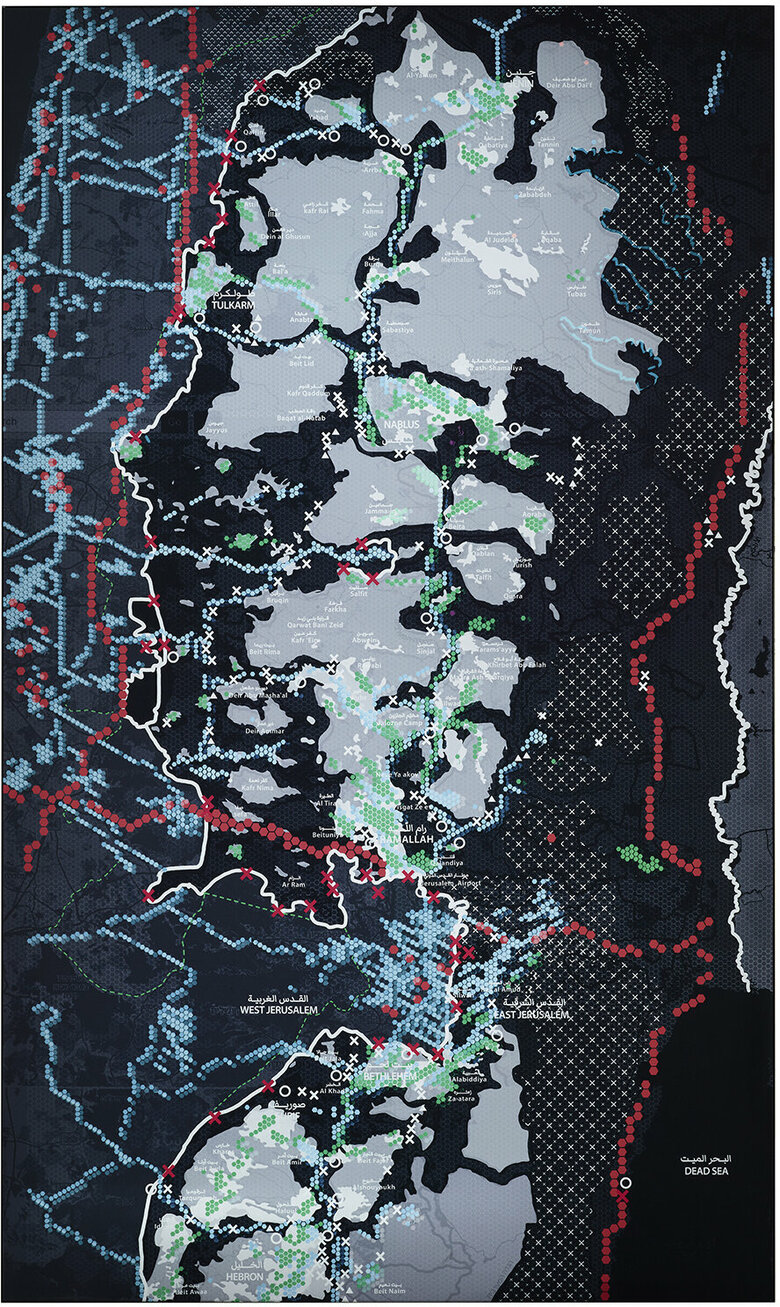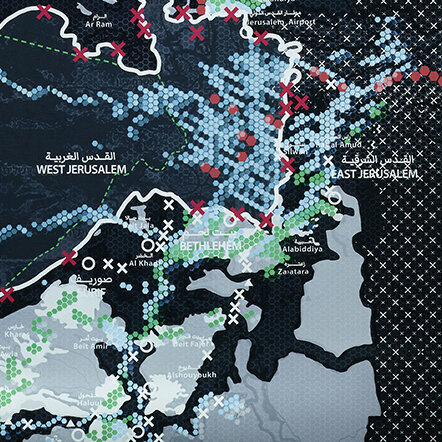Jumanah Abbas, born in Ireland in 1994, is an artist and academic researcher whose formative years from 1995 to 2003 in Ramallah, Palestine, were deeply influenced by the sociopolitical unrest...





Jumanah Abbas, born in Ireland in 1994, is an artist and academic researcher whose formative years from 1995 to 2003 in Ramallah, Palestine, were deeply influenced by the sociopolitical unrest...
Jumanah Abbas, born in Ireland in 1994, is an artist and academic researcher whose formative years from 1995 to 2003 in Ramallah, Palestine, were deeply influenced by the sociopolitical unrest during the first and second Intifadas – which were popular uprisings of Palestinians in the West Bank and Gaza Strip aimed at ending Israel's occupation of those territories. These major Palestinian uprisings were marked by protests, military presence, and strict restrictions on movement that impacted Abbas’s daily life. In 2018, Abbas graduated with a Bachelor's degree in Architecture from the American University of Sharjah, later earning a Master’s in Critical, Curatorial, and Conceptual Practices from Columbia University, in 2020. Her studies pushed forward a multidisciplinary perspective, allowing her to view architecture as a means to investigate issues of human rights and social justice. This, in turn, led her to integrate art with activism, tackling the intersections of architecture, sound, and technology within geopolitical contexts.
Growing up amidst checkpoints, periodic visa renewals in Jordan, and the complex dynamics of living in occupied territory, Abbas developed a profound awareness of displacement and restricted movement. These early encounters with limitation and instability became the foundation of her creative and academic pursuits. Over time, her experiences led her to critically explore themes that intersect with socio-political aspects of both art and architecture, focusing on how space, movement, and control shape the human experience within contested geographies. Her work aims to transform these personal encounters into universally significant pieces, challenging viewers to consider the impact of invisible structures on individual and collective identities.
As a Palestinian architect and curator, Jumanah Abbas investigates the political dimensions of the electromagnetic spectrum and frequencies, particularly within the fragmented landscapes of Palestine. Her work visualizes how invisible forces – such as radio waves, surveillance, and electromagnetic interference – infiltrate daily life and reinforce control in occupied territories like the West Bank. By using mapping, soundscapes, and multimedia installations, Abbas reveals how these unseen networks of influence extend beyond physical barriers, embedding control within the very frequencies that manage communication and access to information. Her projects challenge viewers to consider how these invisible forces shape spatial and social realities, creating layered experiences of constraint and resilience within occupied spaces.
One of her significant works, There’s a Vicious War Launched in the Area of Frequencies, 2023, explores the impact of electromagnetic interference on Palestinian urban soundscapes in the West Bank. This light box installation, measuring 250 x 150 x 10 cm was displayed at the Ramzi and Saeda Dalloul Art Foundation in Beirut, as part of the Hope in an Age of Dystopia exhibition in 2023. It presents a digital map printed on luminous fabric and backlit with LED lights, creating a direct and immersive visual experience. The work combines detailed cartographic elements with data visualization techniques, showing the complex and often invisible layers of surveillance and control within Palestinian territories.
There’s a Vicious War Launched in the Area of Frequencies uses distinct colors and coded symbols to represent areas of limited connectivity and surveillance points across the West Bank, emphasizing the disparities in access between Palestinian communities and Israeli settlers. The visual arrangement of electromagnetic frequencies suggests how the airwaves are weaponized, turning the unseen electromagnetic range into a contested space. The map combines field recordings, interviews, and technical data, which highlight the voices and lived experiences of those affected. Abbas invites viewers to confront the ways in which technology, often seen as neutral or even liberating, is instead utilized as a tool of colonial control within occupied spaces.
By transforming technical data into an artwork, Abbas makes the hidden mechanisms of domination that invade the West Bank visible. Through this layered practice, she challenges viewers to question the widespread influence of electromagnetic surveillance and to recognize resilience within constrained spaces. The LED-backlit design intensifies the work, casting a light that both reveals and interrogates the intersections of technology, space, and power, making it a persuasive statement on the socio-political dimensions of connectivity and resistance.
Another significant project by Abbas is Mapping Memories of Resistance: The Untold Story of the Occupation of the Golan Heights, 2020, which is a collaborative research project with the London School of Economics and Birzeit University, and Al Marsad. This project resulted in a book about recognizing the history filled with struggle and resistance of the Jalwans – the Arabic term for the indigenous people of the Golan. Abbas’s contribution to the project came in the form of critiquing the role of maps within the history of the Jalwan, and issues such as agriculture, identity politics, and infrastructures of leisure like the ski resort at Mount Hermon. Through this work, Abbas critiques the traditional role of maps as instruments of territorial control, demonstrating that they can also be reimagined as tools of resistance.
Abbas employs mapping to document and preserve the experiences of those living under occupation, capturing voices and stories that challenge forced boundaries and reclaim narratives within contested spaces. The project includes layers of geographic and socio-political data, intertwined with personal accounts and historical records, revealing the experiences and resilience of communities affected by the occupation.
Mapping Memories of Resistance offers an alternative use of cartography – where maps, rather than reinforcing power structures, become a means of documenting lived realities and cultural persistence. By integrating telecommunications as a medium, Abbas highlights the role of technology in both surveillance and community connection, examining how communication networks can either divide or empower. Mapping Memories of Resistance invites viewers to question the inherent biases of maps and to consider the potential of cartography as an act of defiance against erasure and control.
Throughout her career, Jumanah Abbas has had impactful collaborations with institutions such as the Palestinian Museum and the London School of Economics, contributing to projects that bridge art, architecture, and political discourse. While residing in Doha, Abbas took part in the Rubaiyat Qatar quadrennial project. She also took part in a unique artist performance featured in 2024 at the Alserkal Arts Foundation in Dubai. Her contribution, titled Listening to Maps Closely, is a presentation that draws on her research into technologies of control and forms of resistance through mapping and telecommunications in the occupied territories, including the Golan Heights and the West Bank.
Abbas’s interdisciplinary approach has influenced both curatorial and architectural practices, bringing attention to the impact of sound, electromagnetic frequencies, and technology on physical and digital spaces. Her work challenges traditional views of space and connection, encouraging audiences to think about how these elements shape life in politically charged areas. Currently based in the UAE, Abbas continues to blend art with research, using her work to explore complex social and political issues. She remains a prominent voice in examining technology’s often-hidden effects on modern life while working at the Guggenheim in Abu Dhabi.
Notes
1 Christine Labban, Interview with Jumanah Abbas. Dalloul Art Foundation. 2024.
2 Christine Labban, Interview with Jumanah Abbas. Dalloul Art Foundation. 2024.
3 Fire Station. "Jumana Abbas." Accessed October 6, 2024. https://firestation.org.qa/en/residents/jumana-abbas/
4 “Hope in an Age of Dystopia.” n.d. Dalloul Art Foundation. https://dafbeirut.org/en/events/Hope-in-an-age-of-dystopia.
5 Christine Labban, Interview with Jumanah Abbas. Dalloul Art Foundation. 2024.
6 Christine Labban, Interview with Jumanah Abbas. Dalloul Art Foundation. 2024.
7 “Mapping Memories of Resistance Curriculum.” Issuu. October 26, 2023. https://issuu.com/interim-studio/docs/cab_curriculum_booklet_online.
8 Alserkal Arts Foundation. "A Prelude to Zifzafa." Accessed October 6, 2024. https://alserkal.online/event/a-prelude-to-zifzafa.
9 Christine Labban, Interview with Jumanah Abbas. Dalloul Art Foundation. 2024.
Sources
Arab Gulf States Institute in Washington. "Jumanah Abbas." Accessed October 6, 2024. https://agsiw.org/associates/jumanah-abbas/
“Hope in an Age of Dystopia.” n.d. Dalloul Art Foundation. https://dafbeirut.org/en/event... Station. "Jumana Abbas." Accessed October 6, 2024. https://firestation.org.qa/en/... Museum. "Screens Series: EcoRove (Jumanah Abbas, Iyad Abou Gaida, and Em Joseph)." Accessed October 6, 2024. https://www.newmuseum.org/exhi... Arts Foundation. "A Prelude to Zifzafa." Accessed October 6, 2024. https://alserkal.online/event/... Memories of Resistance Curriculum.” 2023. Issuu. October 26, 2023. https://issuu.com/interim-studio/docs/cab_curriculum_booklet_online.
Christine Labban, Interview with Jumanah Abbas. Dalloul Art Foundation. 2024.
Selected Group Exhibitions
Hope in an Age of Dystopia, Dalloul Art Foundation, Beirut, Lebanon
A Prelude to Zifzafa, Conversations around sonic autonomy, Alserkal Avenue, Dubai, UAE
EcoRove: Screens Series, New Museum, New York City, United States
6th Lisbon Architecture Triennale 2022, Terra Biennial, Lisbon Architecture Triennale, Lisbon, Portugal
I Had Come from the Sea, The Reef, Los Angles, United States
There’s a vicious war launched in the area of frequencies, Annual Ajyal art Festival, Doha, Qatar
Doppleganger, Maraya Art Center, Sharjah, UAE
Vantage Point 4, Sharjah Art Foundation, Sharjah, UAE
Residencies
2022-23 Curator in Residence, Fire Station, Qatar
Collections
Ramzi & Saeda Dalloul Art Foundation, Beirut, Lebanon
Join us in our endless discovery of modern and contemporary Arab art
Get updates from DAF
Follow Artists
Save your favourite Artworks
Share your perspectives on Artworks
Be part of our community
It's Free!
We value your privacy
TermsCookiesPrivacy Policies
Get updates from DAF
Follow Artists
Save your favourite Artworks
Share your perspectives on Artworks
Be part of our community
It's Free!
We value your privacy
TermsCookiesPrivacy Policies
Get updates from DAF
Follow Artists
Save your favourite Artworks
Share your perspectives on Artworks
Be part of our community
It's Free!
We value your privacy
TermsCookiesPrivacy Policies
If you have entered your email to become a member of the Dalloul Art Foundation, please click the button below to confirm your email and agree to our Terms, Cookie & Privacy policies.
We value your privacy, see how
Get updates from DAF
Follow Artists
Save your favourite Artworks
Share your perspectives on Artworks
Be part of our community
It's Free!
We value your privacy
TermsCookiesPrivacy Policies